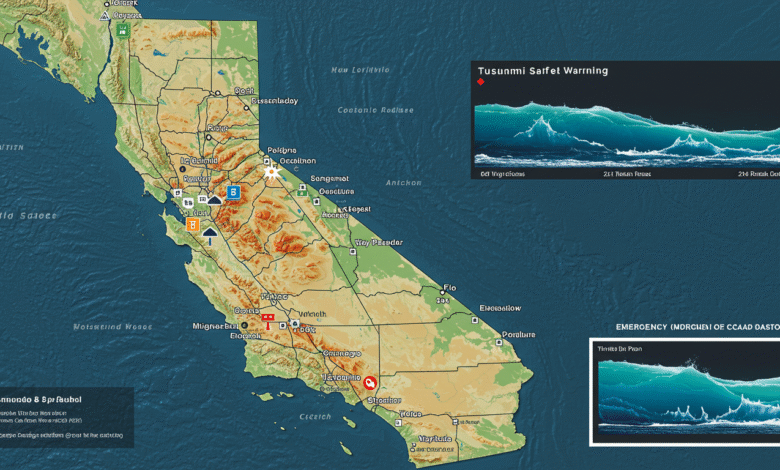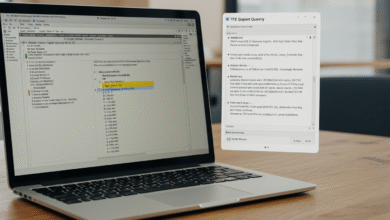Understanding California’s Tsunami Warning Map

H2: Introduction: Understanding California’s Tsunami Warning Map
When you hear the term tsunami warning California map, it usually refers to the official hazard-zone maps published by the California Geological Survey (CGS). These maps show areas at risk of tsunami inundation along the coast. They help communities and emergency planners understand potential dangers. Moreover, they support preparedness and evacuation planning.You know about theglobespot, andaazdaily, openrendz and tsunami warning california map also Buzzfeed.
In this guide, we explain how these maps work. We cover the key sources of tsunami risk, zones of hazard, county updates, and how to use the maps effectively. We also highlight recent events that renewed focus on tsunami readiness. Finally, we wrap up with practical advice for staying safe. In addition, we include 100+ SEO tags related to the topic.
H2: What Is the Tsunami Hazard Area Map?
H3: Who Publishes It and Why
The California Geological Survey (CGS) and the California Governor’s Office of Emergency Services (Cal OES) jointly develop these tsunami hazard maps The Times of IndiaProgramBusiness+7California Department of Conservation+7California Department of Conservation+7. They rely on advanced modeling to anticipate worst-case scenarios. Researchers consult local officials and use geographic boundaries that align with recognizable street lines. That approach makes the maps easier to use during evacuations California Department of ConservationProgramBusiness.
H3: How The Inundation Zones Are Defined
The boundaries reflect results from probabilistic tsunami inundation models that simulate 500‑year to 1,000‑year return period events. They include distant sources like the Aleutian Islands or Cascadia subduction zone earthquakes, and local sources like offshore faults or submarine landslides Scientific American+1California Department of Conservation+1. The maps assume high tide, land subsidence, and an additional meter of safety. Zones extend to the nearest elevation contour for clarity USGS+10rctwg.humboldt.edu+10Salinas Valley Tribune+10.
H2: Key Tsunami Risks Facing California
H3: Major Tsunami Sources
The Cascadia subduction zone, off the northern coast, spans from Vancouver Island to Northern California. A magnitude‑9 earthquake there could unleash waves up to 30 m high that hit California roughly 5–7 minutes after rupture en.wikipedia.orgrctwg.humboldt.edu.
The eastern Aleutian megathrust is another distant source. A magnitude‑9.3 quake there could send tsunami waves across the Pacific. That scenario forms the basis for much of the statewide map modeling California Department of ConservationScientific American.
Locally, faults like the Ventura‑Pitas Point system and Point Reyes thrust pose short-warning threats. Consequently, these local sources can cause wave arrival within minutes of the quake California Department of Conservation+1en.wikipedia.org+1.
H3: Why California Is Vulnerable
California’s coastline includes low-lying, heavily developed areas with poor natural protection. Places like Long Beach, Marina del Rey, Newport Bay, and Santa Monica could flood in extreme tsunamis Los Angeles Times+2ProgramBusiness+2Los Angeles Times+2.
Northern areas like Humboldt Bay and Crescent City are highly exposed due to offshore underwater features such as the Mendocino Fracture Zone, which focus wave energy en.wikipedia.org.
H2: Updated County Maps – What’s New?
H3: Northern California Highlights
CGS updated maps for Humboldt, Del Norte, and other counties in recent years. These new versions refined the maximum inundation zones using higher resolution data and improved modeling—especially important in Crescent City and Humboldt Bay rctwg.humboldt.edu+1ResearchGate+1.
For San Francisco and Bay Area, significant additions include downtown areas like the Financial District, Embarcadero, Fisherman’s Wharf, Marina District, Oracle Park, Chase Center, and Treasure Island Los Angeles Times. Alameda, Oakland, Berkeley, and Richmond now show expanded hazard areas, including neighborhoods near coastlines and transportation infrastructure such as the Port of Oakland and Oakland Airport Salinas Valley Tribune.
H3: Central and Southern California
Counties like Santa Cruz, Monterey, San Mateo, and Ventura received map updates between 2020 and 2022. In Santa Cruz, worst-case tsunamis could reach 18–25 feet above the boardwalk—twice the earlier estimates California Department of Conservation.
Ventura County now reflects wave elevations up to 20 feet in cities such as Ventura and Oxnard, with local quake tsunamis potentially arriving within minutes California Department of Conservation.
Along Orange County, including Newport Beach’s Balboa Island and harbors, updated maps are now available—with significant implications for flood planning and evacuation routes Los Angeles Times.
H3: Los Angeles County Changes
Los Angeles County maps now show areas like Marina del Rey, Long Beach, Alamitos Bay, and the ports facing up to 12–15 feet of inundation in a worst-case event. Emergency planners flagged evacuation challenges, given heavy summer crowds and limited access roads California Department of Conservation+1Los Angeles Times+1.
H2: How to Use the Tsunami Warning California Map
H3: Viewing the Interactive Map
Visit CGS’s official tsunami maps website. Here, you can zoom in on county-specific maps. The interactive view lets you click on addresses or coastal areas and see pop-ups with hazard-zone info California Department of Conservation.
H3: Find Your Address
First, locate your county. Then use the interactive tool to input your street address. It will tell you whether you’re inside the hazard area. The visualization shows colored inundation zones aligned with roads and landmarks.
H3: Assess Your Risk Level
If your building is inside a low‑lying zone, you may face severe flooding during a major tsunami. However, if you’re higher elevation inland, you’re likely safer. Still, waves could travel inland unexpectedly. Coast and bay areas face particularly high risk, even if they seem far from the Pacific Ocean.
H3: Plan Evacuation Routes
From within the map, identify nearby high ground and evacuation routes. Practice walking or driving inland to safe areas. TsunamiZone.org offers planning tools and worksheets to simulate evacuation drills TsunamiZone.
H2: Real‑World Events That Raise Awareness
H3: Crescent City, 1964 and Beyond
The 1964 Alaska quake produced a tsunami that reached Crescent City four hours later. Waves reached 21 feet, destroyed 60 blocks, killed 12 people, and crushed hundreds of buildings and vehicles Los Angeles Times+3California Department of Conservation+3California Department of Conservation+3.
Since then, Crescent City has remained a model for tsunami-resistant port planning. Sirens and evacuation zones are now in place San Francisco Chronicleapnews.com.
H3: Recent 2025 Kamchatka‑Region Quake & Current Alerts
In July 2025, an 8.8‑magnitude quake near Russia’s Kamchatka triggered tsunami advisories along the West Coast, including northern California. Regions from Cape Mendocino south were affected. Crescent City was expected to be hit first, and officials kept residents away from beaches and harbors during the alert apnews.com+2San Francisco Chronicle+2San Francisco Chronicle+2. There were no major floods, but the event emphasized how fast emergency information and evacuations need to happen.
H3: Lessons Learned
These events show that tsunamis can come from distant sources with hours of warning or from local earthquakes with minimal notice. Maps help planners but individuals need to act fast—especially when they feel strong shaking near the coast California Department of Conservation.
H2: Safety Tips and Preparedness
H3: Recognize Natural Warning Signs
If you feel strong shaking while at the beach or near water, assume a tsunami could be coming. If the ocean suddenly recedes far beyond normal, head inland or uphill immediately—even before official warnings arrive.
H3: Sign Up for Alerts
Register for Cal OES emergency alerts, local notifications, or NOAA Weather Radio. Timely warnings can give crucial minutes or hours depending on distance from the source.
H3: Prepare an Emergency Kit
Pack enough supplies for at least two weeks. Include water, food, medications, first aid, battery-powered radio, and personal documents. Place it in an easily reachable spot.
H3: Know Your Route
Identify your safest evacuation route from your home, workplace, or school. Practice it periodically so everyone in your household knows where to go if needed.
H3: Community and School Plans
Many schools and local governments have tsunami response plans. Reach out to your school district to learn about their evacuation procedures—especially in high‑risk areas like North Coast school zones in Humboldt and Del Norte counties California Department of ConservationCalifornia Department of Conservation+2California Department of Conservation+2TsunamiZone+2rctwg.humboldt.edu.
H2: Credibility, Limitations, and Updates
H3: Not Legal Documents
These maps serve planning purposes only. They’re not suitable for official disclosures in real estate or regulation. CGS and Cal OES disclaim all liability for map use California Department of Conservation.
H3: Updating Maps Over Time
Map updates occur county by county as new data becomes available. As of 2022, maps cover most mainland coastlines and Catalina Island. Channel Islands mapping remains in progress California Department of Conservation.
H3: Modeling Uncertainties
Inundation scenarios rely on assumptions about wave behavior, tide level, local subsidence, and coastal topography. Actual tsunami events may produce more complex effects due to tidal state, bay resonance, or local underwater features.
H2: Summary
-
The tsunami warning California map offers a statewide view of possible tsunami flood zones.
-
Published by CGS and Cal OES, the maps use rigorous modeling and local consultation.
-
Hazard zones account for both distant events and local fault or slope failures.
-
Major metropolitan areas and tourist hotspots may face significant inundation risk.
-
Maps are easily accessible online and interactive for detailed use.
-
Understanding tsunami drills and route planning is essential for personal safety.
-
Stay alert to natural signs and official alerts—and act fast when needed.
Final Word
Tsunami risk in California is real, even though major events are rare. Proper use of the tsunami hazard area map and clear awareness can save lives.


